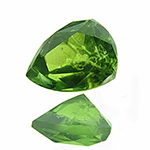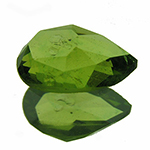Vesuvianite
Also called Idocrase.
A relatively common mineral of the silicates and germanates class.
Gem quality is very rare, however.


Two excellently coloured Vesuvianites from a source in Ethiopia which was only discovered at the beginning of the millenium.
Origin of name:
At first the mineral was believed to be "Hyazinthe" (old name for brown, red and orange Zircon) and called "hyacinthus dictus octodecahedricus" by Moritz Anton Kappeler, Swiss doctor and scientist, in 1723.
Re-named "hyacinte de vesuve" in 1772 by the French mineralogist and founder of modern crystallography Jean-Baptiste Louis Romé de L’Isle.
Finally Abraham Gottlob Werner, German mineralogist, recognized it as a mineral of its own and named it Vesuvian, after the only known source near the Italian volcano.
Since Vesuvianite appears in many different crystal shapes, French mineralogist Rene Just Haüy introduced the name Idocrase (Greek, mixed form).
Synonyms and trade names: Vesuvian (in German speaking countries), Idocrase, Jevreinovite (unknown origin). A dense green jade-like variety is known as Californite.
Cyprine is a light blue variety from Norway.
Can be confused with: Vesuvianite comes in many colours and thus can be confused with a great number of gemstones.
Green Vesuvianite can be confused with e.g. Peridot, green Tourmaline (Verdelite), green Garnet (Demantoid and Tsavorite), Epidot, green Zirkon and others
Locations: mindat.org lists more than 1400 locations.
Gemmy material comes from e.g. Kenya, Tanzania, Canada and, since the beginning of the millenium, Ethiopia.
Handling: due its rarity, Vesuvianite is not commonly used in jewellery.
It is rather hard and shows only indistinct cleavage. However, Vesuvianite is brittle, sensitive to heat and acids and must not be treated galvanically.
Worth knowing: due to the variable chemical composition, physical and optical properties may vary sigfnificantly,
 Deutsch
Deutsch